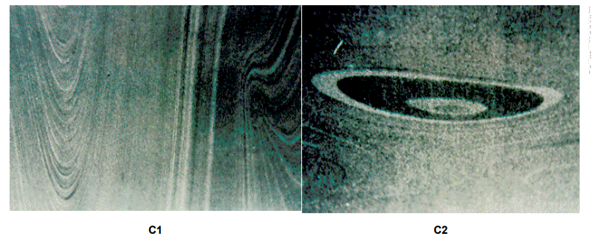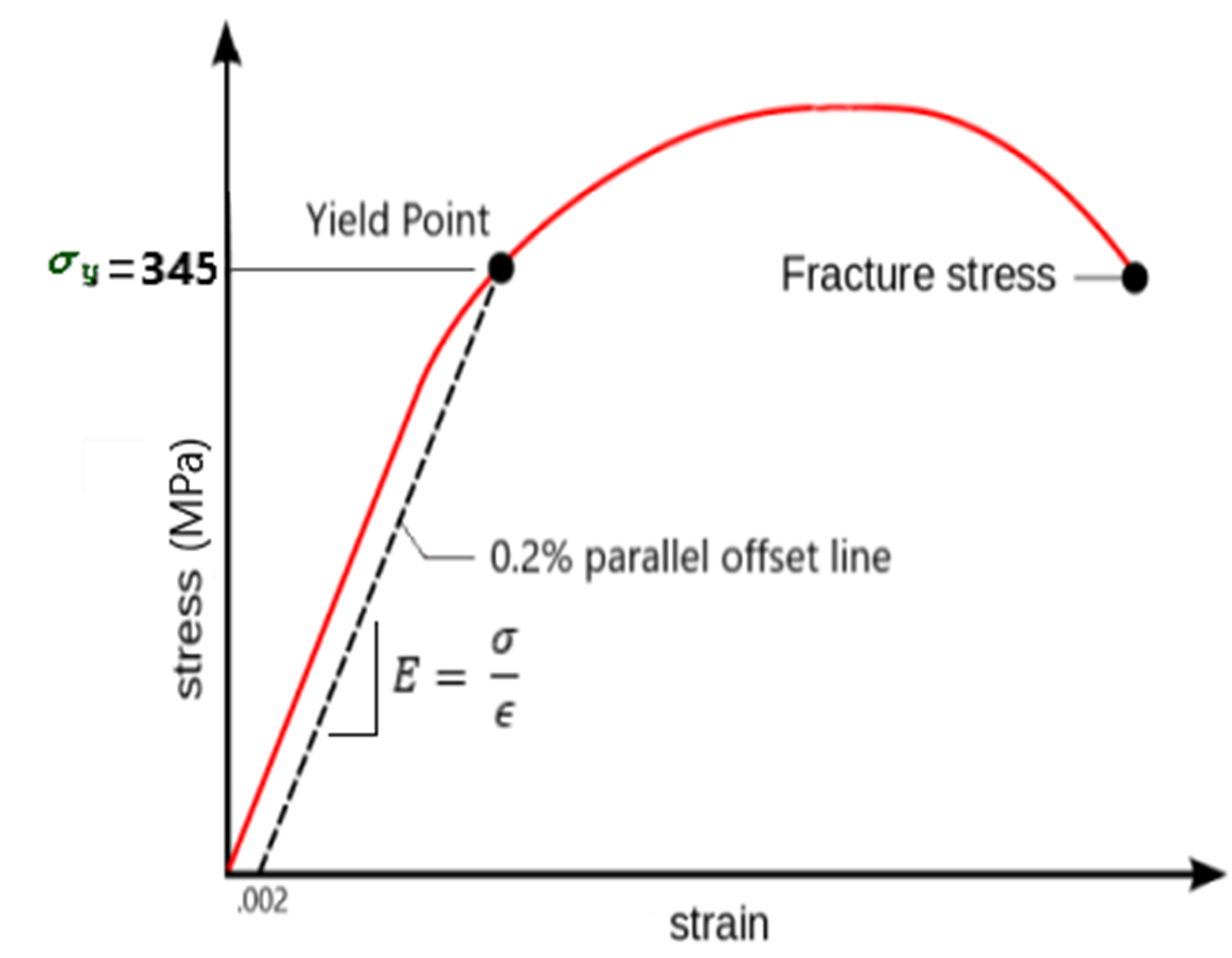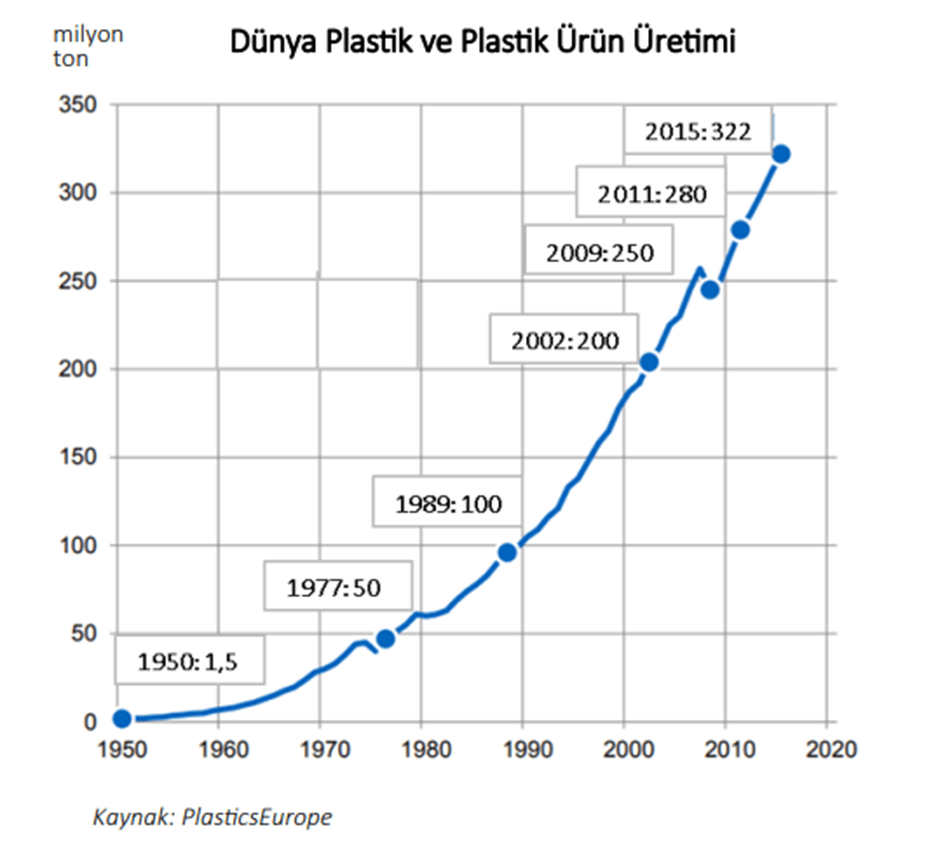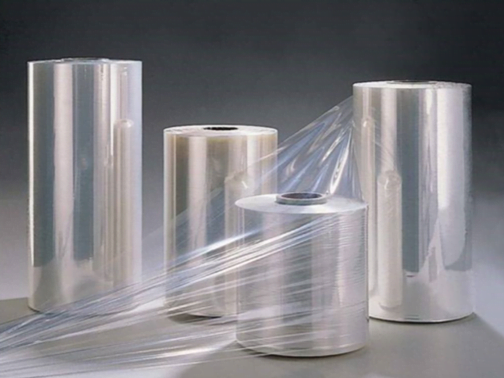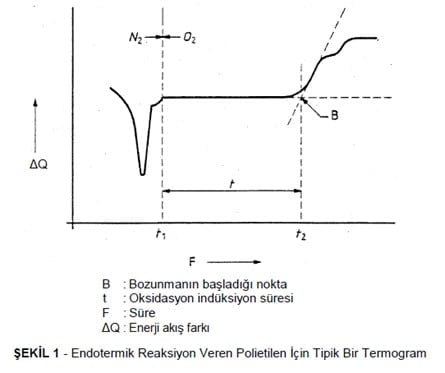What is Carbon Black?
Carbon black is a pigment formed by the reaction of a hydrocarbon fuel, such as oil or gas, with a limited amount of combustion air at temperatures between 1320 and 1540 °C. It is a very fine, fluffy powder with a large surface area, consisting mainly of carbon. Although carbon black has 95% carbon content, it also contains small amounts of oxygen, hydrogen, and nitrogen.
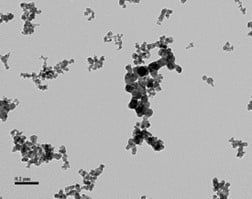
“The View of Carbon Black under the Microscope.”
Production Methods of Carbon Black
As a result of production methods, carbon black varieties with different standards emerge. Carbon black can have different “Carbon Particle” sizes, “Aggregate” sizes, and “Agglomerate” sizes depending on the production method. These 3 dimensions determine the main property characteristics of carbon black. Carbon particle sizes can range from 10 nm to 500 nm.
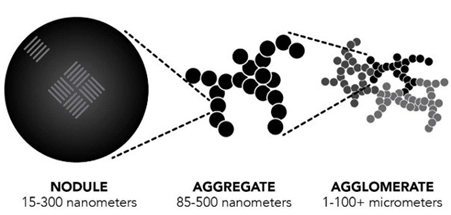
“Carbon particle, Aggregate structure consisting of particles and Agglomerate structure and size ranges formed by connecting aggregates to each other.”
The dyeing power, color tone, ultraviolet resistance, dispersibility, and similar important properties of carbon black depend on the 3 dimensions given above.
Basically, Carbon Black is obtained by breaking down hydrocarbons into carbon and hydrogen components by thermal decomposition or thermal oxidation decomposition methods. The most common production method is the “Furnace Black Reactor,” which belongs to the basic oxidation separation group.
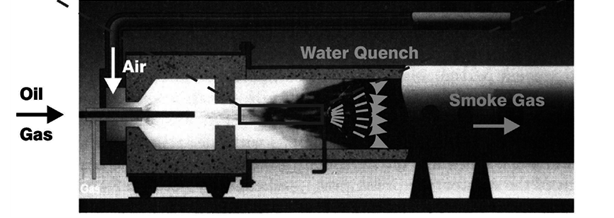
“Schematic view of carbon black processing in a furnace reactor.”
Carbon Black Nominations and ASTM Codes
Carbon blacks are named according to the system in which they were first produced and, as a result, according to the properties they have.
- PURE Carbon Black: “Super Abrasion Furnace Black” – Super Abrasion Furnace Black
- HAF Carbon Black: “High-Abrasion Furnace Black” – High-Abrasion Furnace Black.
- SRF Carbon Black: “Semi-Reinforcing Furnace Black” – Semi-Reinforcing Furnace Black.
The coding given to determine the Carbon Black type has been redefined by the American Society for Testing and Materials (ASTM) to provide more detailed information. The ASTM code starts with the N or S code first.
Given as “N: Normal Cure” , “S: Slow Cure”. It is given for the suitability of carbon black in “cure” (remediation) processes of rubber. For example,
- N330 Carbon Black: According to the previously mentioned coding, it is in the HAF Carbon Black group.
- N770 Carbon Black: It is in the SRF Carbon Black group.
N330 and N770 carbon blacks are the most common carbon blacks used in the plastics industry.
Carbon blacks used in rubber applications are typically classified as N100 – N900 series blacks, where increasing N numbers indicate decreased surface area and increased grain size. As the grain size increases, the carbon black mixing time, viscosity, abrasion resistance, and hardness decrease.
| ASTM | Name | Surface Area (m2/g) | Particle Dimension (nm) |
|---|---|---|---|
| N220 | ISAF – Intermediate Super Abrasion Furnace | 110-140 | 20-25 |
| N330 | HAF – High Abrasion Furnace | 70-90 | 26-30 |
| N550 | FEF – Fast Extrusion Furnace | 36-52 | 40-48 |
| N660 | GPF – General Purpose Furnace | 31-39 | 50-54 |
The first number, such as 3 and 7 in the ASTM code, gives the group number where carbon black is found and it gives the user an idea of the average particle size of the carbon black.
| Group Number | Average Particle Size (mm) | Average Surface Area (m2/g) |
|---|---|---|
| 0 | 0 – 10 | > 150 |
| 1 | 10 – 19 | 121 – 150 |
| 2 | 20 – 25 | 100 – 120 |
| 3 | 26 – 30 | 70 – 99 |
| 4 | 31 – 39 | 50 – 69 |
| 5 | 40 – 48 | 40 – 49 |
| 6 | 49 – 60 | 33 – 39 |
| 7 | 61 – 100 | 21 – 32 |
| 8 | 101 – 200 | 11 – 20 |
| 9 | 201 – 500 | 0 – 10 |
The Properties of Carbon Black
Carbon particle size has a significant influence on the characteristic properties of carbon black. Therefore, the most important parameter when talking about carbon black can be called the carbon particle size. Another important parameter is the aggregate size formed by the particles coming together.
Carbon black properties are divided into physicochemical and compound properties.
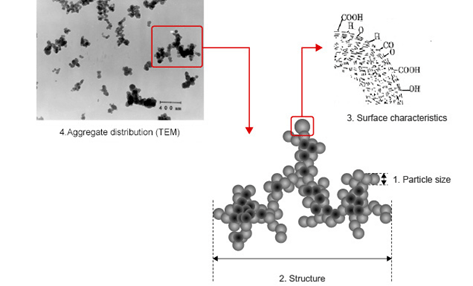
“Carbon Black Structure”
Physico – Chemical Properties
- Particle Size: This refers to the size of a single carbon black particle. The smaller the particle size, the larger the specific surface.
- Structure: This indicates the state of particles adhering to others of similar size and also indicates oil absorption. The greater the oil absorption, the more complex the configuration.
- Surface Characteristic: Various functional groups are combined on the surface of carbon black. We can change the compound properties by changing the surface properties.
- Total Distribution: It is related to the size of the aggregates. If the distribution is sharp, it indicates that there are many clusters of the same size.
Compunded Properties
- Reinforcement: Carbon black is added to rubber used in tire treads, high-pressure hoses, and other demanding applications, and is also added to plastics as a material reinforcement. This property can be divided into carbon black and material physical adsorption (depending on the particle size and structure of carbon black) and particle surface and material chemical reaction of carbon black (depending on the surface properties of carbon black).
- Conductivity: Conductive carbon black is added to natural rubber or other materials to reduce electrical resistance. For example: the conductivity of natural rubber is 1015Ωcm, while the conductivity of conductive rubber (natural rubber + conductive carbon black) is between 1-1015Ωcm. This property is believed to be the result of the structure of the carbon black particles in contact with each other, forming conductive channels or the “tunnel effect” of electrons bouncing between the dispersed carbon black particles.
- Pigmentation: Carbon black has strong coloring properties, is heat resistant and suitable for plastic and film dyeing. This property is believed to be due to the particle size and the interaction of the structure with light.
- Anti-Ultraviolet Degradation Properties: Carbon black is excellent at absorbing ultraviolet light. Adding carbon black to other materials prevents ultraviolet degradation. This is because stress cracking is prevented in plastics containing carbon black, which purifies their crystals.
Intended use of Carbon Blacks
Carbon black is mainly used in the rubber and wheel industries. Carbon black, which is used as a filling material, is used for the purpose of strengthening the material in the wheel, abrasion resistance, and keeping the heat caused by friction on the road. In this way, it is ensured that the life of the wheel is prolonged.
Carbon black is also a good conductor. It is preferred in products where static electricity is not desired, such as car gas caps or fuel pipes.
Carbon black is also mainly used in the plastics industry. It can be preferred for black painting on plastic products. Depending on the type, it can give the product black tones. Carbon black is added to plastic products as a filler (filler) that strengthens them in terms of strength, as in the wheel structure.
Another purpose of use is that carbon black is a good “UV Absorber”. As it is known, when plastic products are exposed to sunlight, both discoloration and deterioration of the product occur due to damage to the bonds in the plastic structure. In this respect, carbon black particles, which are possible in the product, are prevented from damaging the plastic structure of the rays by blocking the UV rays from the sun.
The point to note here is that different types of carbon black have different UV protection properties. One of the most important parameters in this regard is the carbon particle size. The smaller the average carbon particle size, the higher the UV protection capability of carbon black.
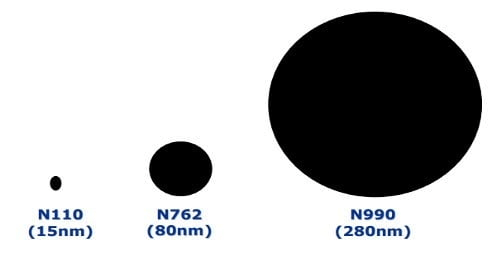
As can be seen in the picture above, the small N110 Carbon Black will provide more excellent UV protection than the N990 Carbon Black.
Another important parameter affecting the UV protection that carbon black will provide in the product is the dispersion of the carbon black in the product. The more homogeneously dispersed the carbon in the black product, the more successful it will be in capturing the sun’s rays, so the higher the UV protection will be.
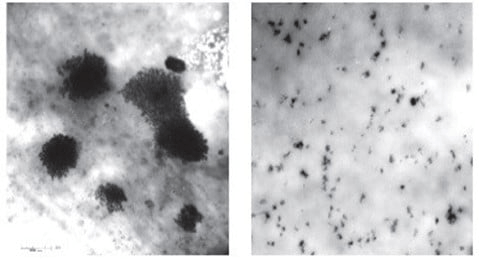
“The distribution of carbon black in the product”
Homogeneous Distribution of Carbon Black
According to the study, pipes with inhomogeneous carbon black distribution showed 80% less elongation than pipes with homogeneously dispersed carbon black distribution. The polymer domains containing less or no carbon black detached from the polymer matrix as the material elongated, eventually leading to breakage much earlier than expected.
In this study, the effect of carbon black dispersion on the deterioration of the mechanical properties of high-density polyethylene in the form of plastic pipes used in water distribution networks was investigated. Polyethylene pipe samples with similar carbon black density but different carbon black distributions were stretched to fracture at different strain rates. The carbon black distributions of the bulk samples and fracture surfaces were investigated using stereo and scanning electron microscopy (SEM). It was found that the carbon black distributions, fracture surfaces, and fracture modes in these pipes were significantly different. Pipes with a certain level of heterogeneity in the carbon black distribution showed ductile and brittle fractures in the same fracture plane, while homogeneous black and natural polyethylene (without carbon black) showed only ductile fractures.
- Brittle Fracture: It is the type of fracture that occurs with little or no plastic deformation on the material surface.
- Ductile Fracture: It is the type of fracture in which plastic deformation occurs to a large extent on the material surface, and, accordingly, observable crack tip blunting occurs.
Homogeneous Distribution Test of Carbon Black
There are internationally accepted tests on how homogeneously dispersed carbon black should be in the product.
- ASTM D2663 : Standard Test Methods for Carbon Black- Dispersion in Rubber
- ASTM D2663 : Standard Test Methods for Carbon Black- Dispersion in Rubber
The ISO 18553 test standard explains how to make the dispersion ratio for plastic products containing 3% or less carbon black. Today, this test can be done automatically with a microscope and computer software. As a result of the test, a degree of dispersion of 1 to 7 is determined. 1 is the best dispersion result, and 7 is the worst dispersion result.
In the pipe industry, a dispersion degree of ≤ 3 is required. For test details, the ISO 18553 test standard should be reviewed.
Carbon Black Distribution Test Procedure According to ISO18553 Standard
Preparation of Samples
- Compression Method
With the help of a scalpel, six samples are taken from different parts of the product, each varying in the range of 0.20 mg ± 0.10 mg, of the product to be analyzed.
The sample is placed between two coverslips to ensure its cleanliness. The sample should be heated so that the product can be observed better under the microscope.
If an oven is to be used, two lamellas are attached to each other with spring clips, and the sample is left in the oven at temperatures between 150 °C and 210 °C for at least 10 minutes to reach a thickness of 20 µm ± 10 µm.
After this process, it should be left to cool for microscopic examination.
- Microtome Method
At least 6 samples of 20 µm ± 10 µm thickness and at least 4 mm in any direction are cut from different parts of the product.
Six samples are placed between one or more coverslips that are sure to be cleaned.
Examination
Particles and agglomerates from each of the 6 samples should be examined under light under a microscope with a magnification of at least x70 and the recommended x100.
Ignoring those smaller than 5 m, the largest size of each particle and agglomerate is measured and recorded.
Afterwards, the rating is made according to the table given below.
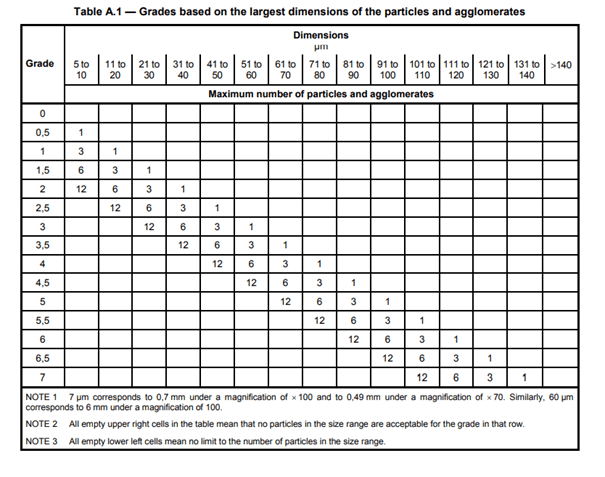
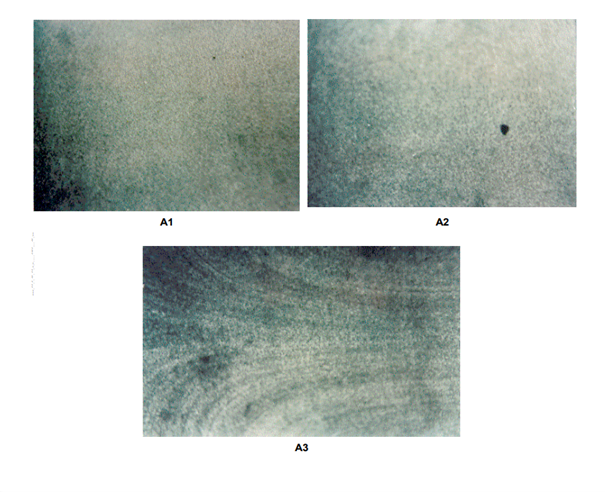
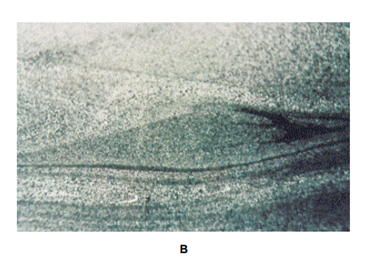
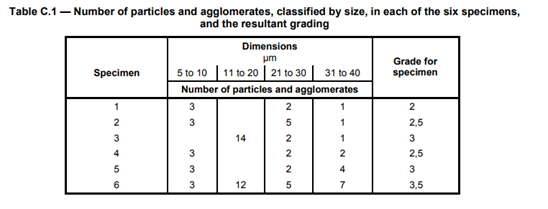
The arithmetic mean of the 6 degrees obtained
(2 + 2,5 + 3 + 2,5 + 3 + 3,5)/6 = 2,75
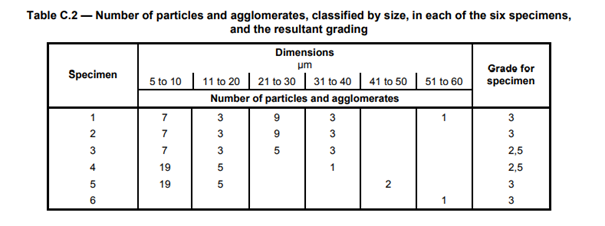
The arithmetic mean of the 6 degrees obtained
(3 + 3 + 2,5 + 2,5 + 3 + 3)/6 = 2,833 ≅ 3
